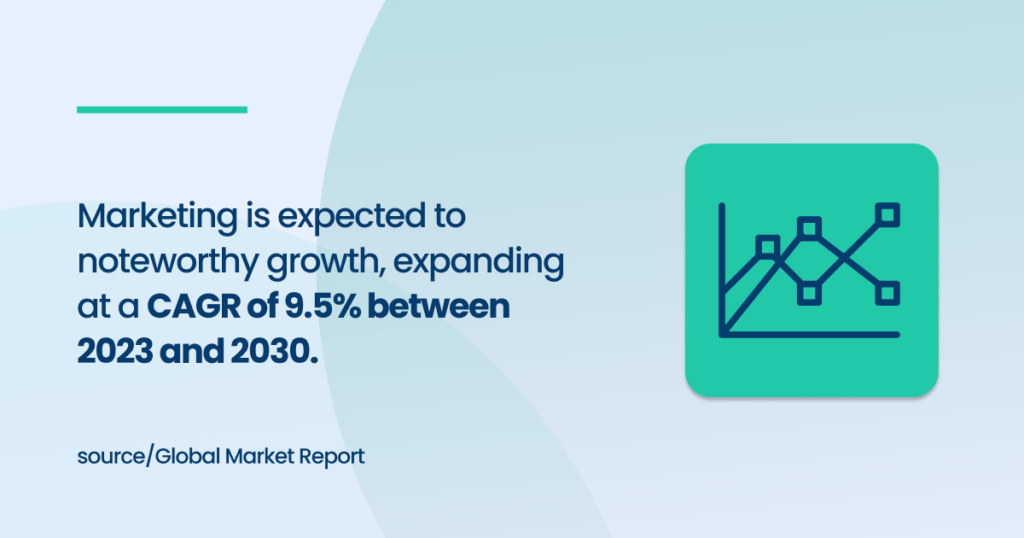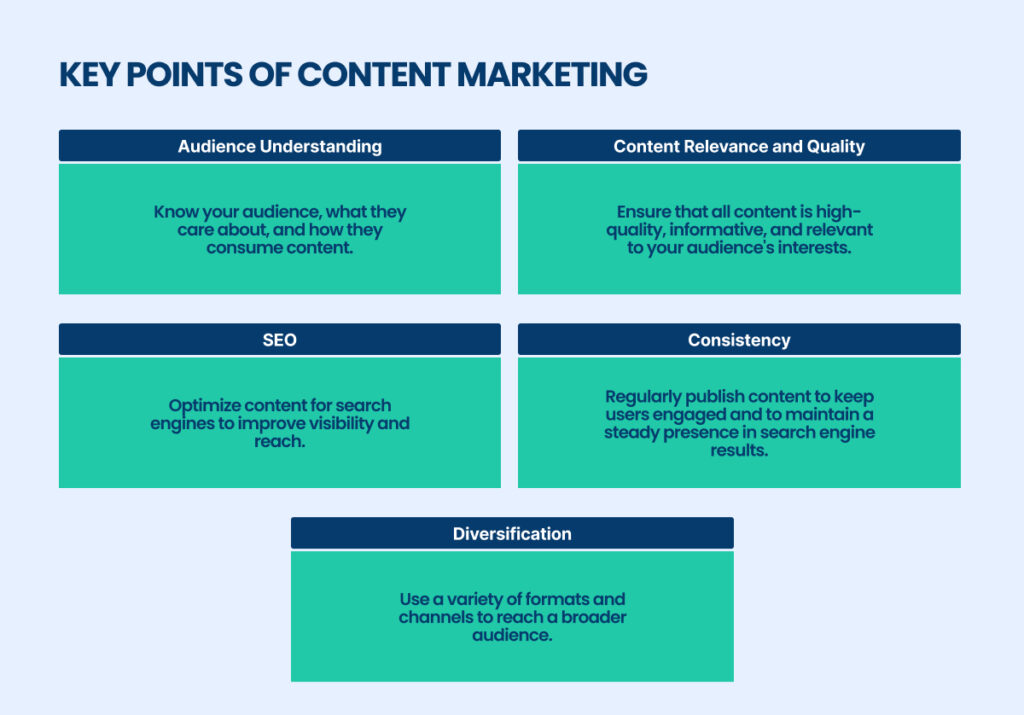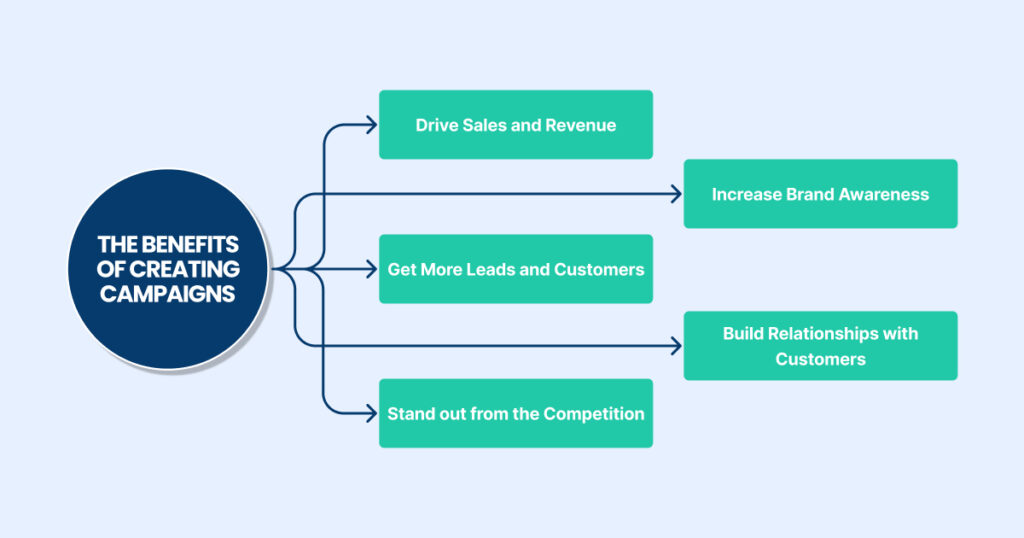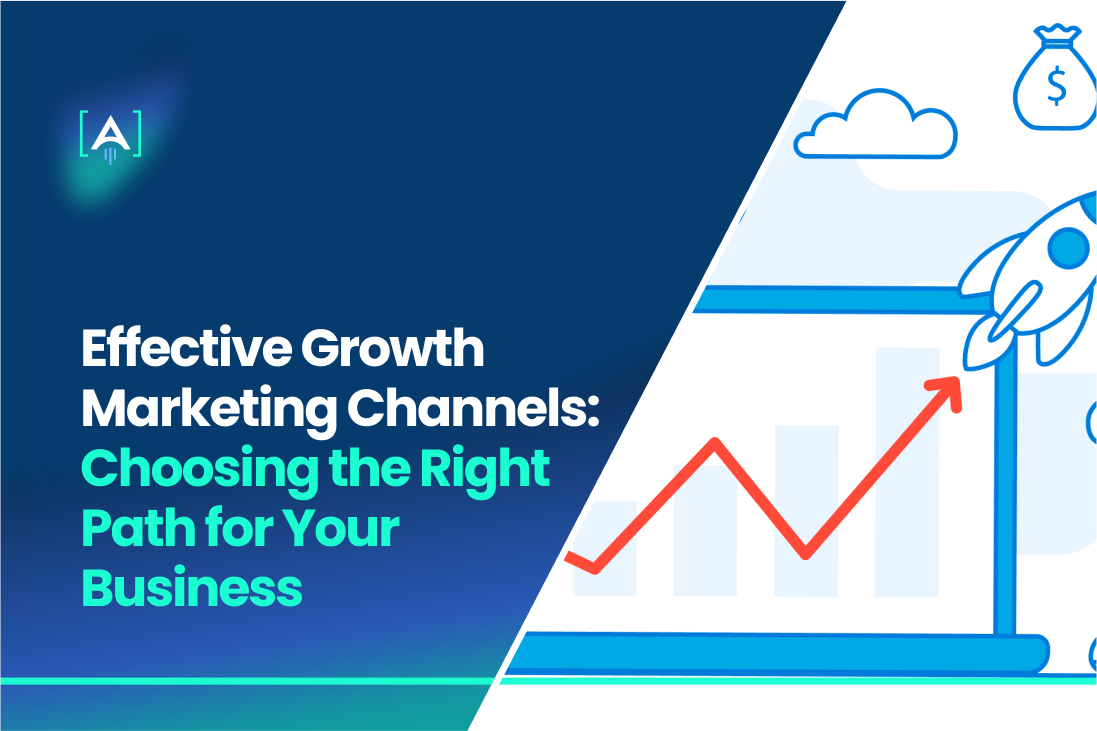Growth marketing transforms traditional marketing by focusing on the top of the sales funnel and a customer’s entire lifecycle.
We must admit that marketing is not just about creating cool ads or catchy slogans.
It’s a data-driven approach that treats marketing like a scientific experiment. A Growth marketing agency and growth marketers are relentless testers, using insights to optimize everything from website design to customer acquisition.

This blog post will generally cover what a marketing channel is, which strategies are effective, and how they can benefit your business’s success.
Understanding Growth Marketing
Have you ever asked what is a marketing channel and how it can be combined with marketing?
Growth marketing is an advanced approach to traditional marketing strategies, focusing on sustainable growth across every customer lifecycle stage.
Unlike conventional methods, which often concentrate only on customers’ initial attraction, growth marketing aims to continuously engage, retain, and maximize the value of customers over time.
Source: HubSpot
This strategy integrates all aspects of marketing—from user acquisition to retention and referral—powered by data-driven experimentation and high-impact tactics.
The cornerstone of growth marketing is its emphasis on measurable outcomes and adaptability. Each initiative or campaign is tested, analyzed, and refined in real-time, ensuring strategies align with dynamic market conditions and customer preferences.
This relentless pursuit of optimization across multiple channels is what defines a robust growth marketing strategy.
The Importance of Choosing the Right Channels
Selecting the right growth marketing channels is crucial for successful marketing strategies.
A marketing channel is any platform or method through which a business communicates with its audience to increase awareness, consideration, and conversion. If you have your answer of what is a marketing channel, then consider its subcategories.
Source: Ahrefs
The effectiveness of a channel can vary significantly depending on the product, market, and target demographic, making the choice of channels a pivotal decision in growth marketing strategies.
Product-Led Growth Marketing
- Incorporating Product Experience: Product-led growth marketing is an example of companies leveraging their products as primary marketing tools. This approach encourages product adoption directly through user experience, often using the product to drive customer acquisition, expansion, and retention.
By providing exceptional value through the product, companies can naturally facilitate customer engagement and advocacy, which are essential for sustainable growth.
Hyperlocal Marketing
- Tailoring Campaigns Geographically: Hyperlocal marketing involves tailoring marketing campaigns to specific geographic areas, often targeting local consumers’ needs and interests. This type of marketing is particularly effective for businesses that depend on local clientele or have a significant physical presence.
Companies can create highly personalized marketing strategies that resonate more deeply with their audience by focusing on well-defined regions.
The term “growth marketing channel” encompasses these and various other ways businesses can engage customers. While thinking what is a marketing channel you need to consider that each channel offers unique advantages and challenges, from social media platforms and SEO to email marketing.
The essence of a successful growth marketing strategy is identifying which channels will most likely reach and resonate with the target audience and then seamlessly integrating these channels to create a cohesive and compelling customer journey.
Integrating Marketing Strategies
- Creating Synergy: Integrating multiple marketing strategies within these channels can amplify the effectiveness of growth marketing efforts.
For instance, combining content marketing to educate consumers, social media campaigns to boost engagement, and email marketing to nurture leads can create a synergistic effect that enhances overall marketing impact.
Moreover, sustainable marketing growth requires attracting customers and keeping them engaged over the long term. This is where the continuous loop of testing, feedback, and refinement in growth marketing comes into play.
By constantly analyzing the idea of what is a marketing channel and highlighting the performance of various channels and strategies, businesses can understand what works and what doesn’t and how to pivot their tactics accordingly.
Assessing Your Business Needs
Before embarking on any growth marketing journey, it’s imperative to assess your business needs thoroughly. This assessment forms the backbone of a concrete growth strategy that aligns with your company’s unique characteristics and goals.
A meticulously tailored approach enhances your competitive advantage and ensures efficient resource allocation, driving sustainable, organic growth.
Identifying Your Target Audience
The first critical step in refining your marketing strategy is clearly defining and understanding your target audience. It is crucial to know who your customers are, what they need, and how they prefer to interact with your brand.
This understanding helps craft tailored messages that resonate deeply with your potential customer base, increasing the likelihood of engagement and conversion.
Utilizing demographic data, customer feedback and market research is essential to painting a detailed picture of your audience. By segmenting your market based on the insights, you can more productively target your campaigns. This is especially important in digital marketing, where specificity can drive higher returns on investment.
Setting Clear Objectives and Goals
Once your target audience is defined, the next step is to set clear, actionable objectives and goals. These should guide all marketing efforts and offer the benchmark against which success can be measured.
Growth marketing goals are often dynamic, responding to market conditions and internal growth stages. They should be specific, measurable, achievable, relevant, and time-bound (SMART).
Short-term Goals vs. Long-term Goals
Differentiating between short-term and long-term goals is vital for strategic planning. Short-term goals typically focus on immediate improvements and quick wins, such as increasing monthly web traffic or boosting lead generation within a quarter.
Source: Smartsights
These goals are crucial for generating momentum and funding ongoing marketing efforts. On the other hand, long-term goals aim at achieving sustainable growth, like establishing a loyal customer base or becoming a market leader.
These objectives require a longer timeline and sustained efforts, which are essential for securing the business’s future stability and scalability.
Budget Considerations
Effective growth marketing also heavily depends on smart budget considerations. Allocating resources wisely between various channels and strategies ensures that you are not just throwing money at various tactics, hoping something sticks.
Source: Statista
It’s about making informed decisions based on the potential return on investment (ROI) each channel offers. Budget planning must account for the direct costs of marketing campaigns and the indirect costs of the tools and technologies needed to execute and measure these campaigns.
Identifying key performance indicators (KPIs) relevant to each goal is crucial for optimizing resource allocation.
These KPIs will assist you to measure the effectiveness of your spending and adjust your strategies accordingly.
For instance, if digital marketing is a primary channel, you might focus on KPIs like cost-per-click (CPC), conversion rate, and customer acquisition cost (CAC).
Overview of Key Growth Marketing Channels
What is Content Marketing?
Content marketing is the practice of creating and distributing valuable, correspondent, and consistent content to attract and retain a clearly defined audience and ultimately drive profitable customer action.
Source: Statista
Unlike paid advertising, which relies on interruptive techniques, content marketing aims to provide useful content to potential customers without selling overtly, thereby adding value to every interaction.
This method has become a cornerstone in the digital marketing strategies of many businesses due to its effectiveness in building a strong relationship with the audience, enhancing brand presence, and driving organic traffic from search engines.
Why Content Marketing is Important for Businesses
Content marketing is crucial for businesses today for several reasons:
- Building Trust and Authority: By providing your audience with helpful and informative content, you establish your brand as an authority in your field, which increases consumer trust.
- Supporting Other Marketing Tactics: It fuels other parts of your marketing strategy. SEO efforts greatly benefit from high-quality content, as search engines reward businesses that publish consistent content.
- Cost-Effectiveness: Once up and running, it can generate over three times as many leads as outbound marketing strategies but costs 62% less.
- Enhancing Customer Retention: Good content is critical for engaging existing customers and encouraging repeat business.
Key Points in Applying Content Marketing
When considering implementing content marketing, several key points should guide the strategy.

Blogs and Articles
Blogs and articles are foundational to content marketing growth. This format allows businesses to delve deeply into topics, showcase their expertise, and share insights that can’t be conveyed effectively through other formats.
The benefits are manifold; blogs enhance visibility on search engines, drive organic traffic, and provide content that can be disseminated across social media platforms, thus enhancing your digital footprint and supporting your growth marketing channels.
Videos and Podcasts
In the digital era, videos and podcasts represent incredibly powerful growth channels. Videos offer a dynamic way to attract audiences, often resulting in higher retention rates and more impactful user engagement.
Source: Wyzovl
They are highly shareable across platforms and can be used to explain difficult products or services effectively, thereby accelerating understanding and interest.
Conversely, podcasts cater to the growing demand for on-the-go content consumption. They are an excellent channel for building a personal connection with your audience, allowing for deep dives into topics that interest them, which builds a community around shared interests.
Source: Wyzovl
Both videos and podcasts support SEO strategies by increasing time spent on your site and provide unique opportunities for repurposing content across other channels, including social media and even influencer marketing, thus increasing the reach and effectiveness of your content marketing efforts.
Social Media Marketing: Platforms Overview and Strategies for Growth
Social media marketing is a dynamic powerhouse in the realm of digital marketing, offering unprecedented opportunities for businesses to achieve rapid growth and significant revenue growth.

Source: Statista
Companies can maximize their reach, enhance brand visibility, attract new customers, and boost customer lifetime value by effectively harnessing the potential of platforms like Facebook, Instagram, and LinkedIn.
Platforms Overview: Facebook, Instagram, LinkedIn
Each social media platform serves distinct audience segments and offers unique tools for marketers to engage with their target demographics.
- Facebook: With billions of active users, Facebook remains a juggernaut in social media marketing. It provides businesses with sophisticated advertising tools and in-depth analytics that help them understand audience behaviors and preferences.
Facebook is particularly effective for building community engagement through posts, comments, and shares and for running targeted advertising campaigns that drive direct responses.
- Instagram: A visually-driven platform, Instagram is ideal for brands with strong visual content that resonates with a younger demographic. It excels in brand storytelling through images, short videos, and Stories, making it a crucial platform for the lifestyle, fashion, and food industries.
Instagram’s integration with Facebook’s advertising system allows for detailed targeting and analytics, enhancing the ability to reach desired audiences effectively.
- LinkedIn: A professional networking site tailored for B2B marketing and professional brand building, LinkedIn is an invaluable tool for establishing thought leadership, generating leads, and recruiting talent.
Content on LinkedIn often includes industry discussions, professional articles, and company updates, making it a prime channel for engaging with professionals and industry leaders.
Paid vs. Organic Reach
In the labyrinth for brand visibility and customer acquisition, businesses often leverage paid and organic strategies on these platforms.
- Organic Reach: Organic social media marketing involves creating and sharing content without paid promotion. The strength of organic reach lies in its ability to build genuine relationships with followers over time, fostering trust and loyalty.
This method relies heavily on creating compelling content that encourages natural engagement through likes, shares, and comments. While organic reach is cost-effective, its impact has diminished on platforms like Facebook and Instagram due to changing algorithms prioritizing user content over businesses.
- Paid Reach: Paid social media campaigns allow for precise targeting of potential customers based on detailed demographic and behavioral data. This approach can quickly amplify brand visibility and accelerate growth by pushing content to a broader audience beyond existing followers.
Paid reach is particularly effective for launching new products, promoting special offers, and boosting traffic to other digital assets like websites optimized for search engines and conversions.
Combining both strategies offers the best of both worlds—building long-term brand loyalty through organic engagement while boosting short-term visibility and sales with paid ads.
Furthermore, leveraging the analytics from both approaches provides valuable insights into customer behavior and campaign effectiveness, informing future marketing decisions and budget allocations.
Email Marketing: Leveraging Newsletters and Drip Campaigns for Effective Communication
Email marketing is one of the most effective growth marketing channels available today.
Source: HubSpot
As a marketing channel, it offers direct and personalized communication with audiences, enabling businesses to nurture leads, enhance customer engagement, and boost conversions with remarkable precision and scalability.
Newsletters
Newsletters are a cornerstone of email marketing strategies. They serve as regular updates that inform your audience about your company’s latest news, insights, products, and offers.
Source: HubSpot
The power of newsletters lies in their ongoing engagement with your subscribers. They provide a platform to deliver valuable content to educate, entertain, and inspire your customers.
Newsletters help build a trusted relationship between your brand and its audience by consistently offering relevant, high-quality content. This encourages loyalty and repeat business. Additionally, the data from newsletter interactions, such as open and click-through rates, can offer valuable insights into consumer behavior and preferences, enabling further refinement of marketing strategies.
Drip Campaigns
Drip campaigns are automated sets of emails that are sent out according to specific timelines or user actions. They are designed to deliver the right information to the right people at the right time, thereby significantly increasing the relevance and effectiveness of the communication.

For instance, a drip campaign might involve sending a welcome email immediately after a subscription, followed by informative emails related to the subscriber’s interests, eventually leading to a sales pitch.
Drip campaigns are particularly effective for leading prospective customers through the sales funnel, from initial awareness to complete purchase decisions.
These campaigns are highly efficient in supporting the customer journey by providing timely information and reminders, helping to keep your brand at the forefront of customers’ minds without overwhelming them.
They can be tailored to customer actions, such as visiting a particular page on your website or abandoning a shopping cart, which makes them highly targeted and effective at converting leads into customers and customers into repeat buyers.
Partner with [A] Growth Agency for Your Marketing Channels
People don’t buy what you do; they buy why you do it. Marketing continues evolving, and clearly understanding what to offer is essential. [A] Growth Agency is the right choice for your business.
We will establish marketing channels to significantly enhance your company’s ability to reach and engage with your target audience. Data is at the heart of effective growth marketing, and we strongly adhere to this approach.
This enables us to understand customer behaviors, preferences, and trends. Moreover, it allows us to make more informed decisions that can lead to better targeting, more personalized experiences, and, ultimately, higher conversion rates.
If this is what you need, we are here.

